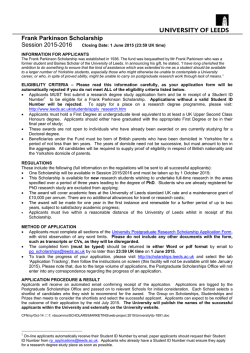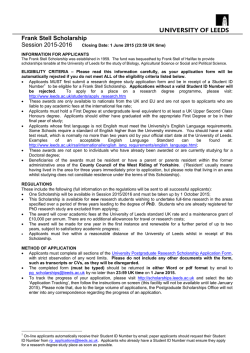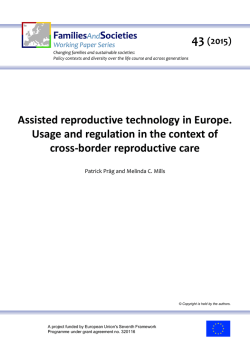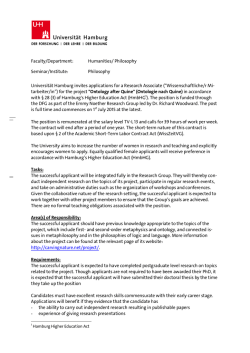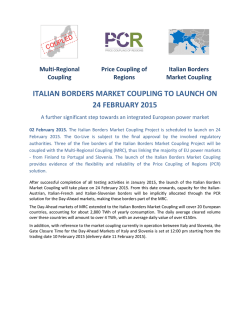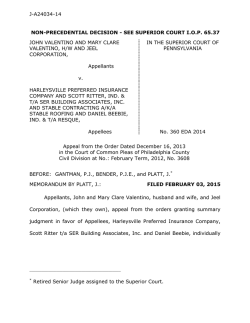
Questions and Answers on the Paradiso and Campanelli v. Italy
Questions and Answers on the Paradiso and Campanelli v. Italy judgment (27 January 2015) This document is a tool for the press, issued in the context of notification of the above judgment. It does not bind the Court. 1. Why has the Court found a violation of Article 8 in the case of Paradiso and Campanelli? The Court considered that the Italian authorities had not given sufficient weight to the best interests of the child when balancing them against public-policy considerations. The authorities had decided to remove the child and to place him under guardianship on the ground that he had no biological relationship with the applicants and that the applicants had been in an unlawful situation (by contacting a Russian agency in order to become parents and subsequently bringing to Italy a child whom they passed off as their child, they had circumvented the prohibition in Italy on using gestational surrogacy arrangements* and the rules on international adoption). In particular, the authorities had not recognised the de facto relationship between the applicants and the child and had imposed an extreme measure, reserved for cases where children were in danger. It is important to note that in this case the Court focused on the removal of the child and his placement under guardianship, and not on the issue of surrogacy. The legal situation in which the child was placed on his arrival in Italy – a parent-child relationship that was not recognised under Italian law – could have arisen from another cause, such as non-recognition of an adoption by an unmarried person, as in the Wagner and J.M.W.L. v. Luxembourg judgment (no. 76240/01, 28 June 2007), cited below). 2. In June 2014 the Court delivered judgments against France on the issue of legal parent-child relationships in respect of children born abroad from surrogacy arrangements. How do these relate to the Paradiso and Campanelli judgment? Do they deal with the same issue? The similarities Both the French and Italian cases concern the issue of the arrival in national territories of children who have been born from surrogacy arrangements abroad. In the Mennesson/Labassee cases, the children had been born from surrogacy treatment carried out in the United States, and, in the Paradiso and Campanelli case, in Russia. More particularly, the cases deal with protection of the rights guaranteed by Article 8 in the context of international surrogacy contracts, especially where the child is born in the territory of one State and the authorities in the State where he or she arrives do not recognise either the legality of contracts of this type or the acquisition of parental rights. In all three cases, the national authorities refused to register the details of the children’s foreign birth certificates in the national civil-status registers, on the ground that such registration would be contrary to public policy (given that surrogacy is illegal in France and Italy, the legal parent-child relationship established abroad is non-existent in the eyes of the authorities). The differences Although Ms Paradiso and Mr Campanelli, like the French applicants, challenged the national authorities’ refusal to recognise a parent-child relationship established abroad, their main complaint concerned the fact that the child had been taken into care by the Italian social services. Thus, although the French cases concerned essentially the issue of the parent-child relationship and the children’s identities, - no children were removed in the French cases – the primary issue in the Italian case is the national courts’ decision to remove the child and to place him under guardianship. In this respect, the Italian case is closer to that of Wagner and J.M.W.L. v. Luxembourg (no. 76240/01, 28 June 2007), which concerned civil proceedings to have an adoption judgment, delivered in Peru, declared enforceable in Luxembourg. This request had been dismissed by the Luxembourg courts, as the Civil Code did not permit full adoption by an unmarried woman. As in the Paradiso and Campanelli case, the authorities had not recognised the parent-child relationship established abroad, on the ground that it went against public policy; however, they took no measures to remove the underage child or to interrupt family life. The Court reiterates in the Paradiso and Campanelli judgment that the interest of the child dictates that family ties may only be severed in very exceptional circumstances – such as violence, physical or psychological ill-treatment, sexual abuse, danger to life, health or moral education, psychological instability on the part of the parents –, and that everything must be done to preserve personal relations and, if and when appropriate, to “rebuild” the family. Two other differences should be noted between the French and Italian cases: - in the French cases, the intended father (the applicant before the Court) was the child’s biological father: it was his gametes which were used in the in vitro fertilisation procedure carried out abroad. In the Italian case, unknown gametes were used, erroneously according to the applicant, who claims that he is unable to explain why his seminal fluid was not used by the Russian clinic as planned. The existence of this biological relationship in the French cases is decisive in the Court’s finding of a violation. In the Mennesson and Labassee judgments, the Court’s analysis of the situation “takes on a special dimension where, as in the present case, one of the intended parents is also the child’s biological parent. Having regard to the importance of biological parentage as a component of identity, it cannot be said to be in the interests of the child to deprive him or her of a legal relationship of this nature where the biological reality of that relationship has been established and the child and parent concerned demand full recognition thereof” (Mennesson judgment, § 100). The finding of a violation in the Italian case is of a different nature, concerning as it does the applicants’ separation from the child and the latter’s placement under guardianship. - in the French cases, the Court examined the applications from the children’s point of view. The parents and children were applicants, but the Court found a violation of Article 8 with regard to the children’s right to respect for their private life, and no violation of this provision with regard to the applicants’ family life. In the Italian case, the Court held that the applicants did not have standing to act on behalf of the child, and the violation of Article 8 was found in respect of the interference in the couple’s family life. 3. Where does the Paradiso and Campanelli judgment fit into the Court’s recent case-law on these matters? Best interests of the child: in line with the Court’s established case-law, where it has to examine whether a fair balance has been struck between the public interest and respect for private and family life, it has regard to the essential principle according to which, whenever the situation of a child is in issue, the best interests of that child are paramount. See the factsheets on Children's rights and Parental rights. In the Paradiso and Campanelli judgment, the Court finds that the State must take into consideration the best interests of the child, irrespective of the parental relationship, genetic or otherwise. De facto family life: the Court has followed the approach taken in the cases of Wagner and J.M.W.L. v. Luxembourg (no. 76240/01, 28 June 2007) and Moretti and Benedetti v. Italy (no. 16318/07, 27 April 2010), in holding that the applicants and the child can argue that there existed a de facto family life, even in the absence of a biological relationship and in spite of the short period during which the applicants looked after the child. The issue of the child’s identity: the Court takes into account the fact that the child was not given a new identity for two years. He received a new identity only in April 2013, which means that he had no official identity for more than two years. Yet, as the Court emphasises, it is necessary to ensure that a child is not disadvantaged on account of the fact that he or she was born to a surrogate mother, beginning with citizenship or identity, which are of crucial importance. The Court also attached great importance to the question of the children’s identity in the Mennesson and Labassee cases, considering that France undermined the children’s identity within French society by denying them their status under French law as the children of the Mennesson and Labassee couples, a status that had been recognised in the United States. − 2/4 − 4. What do these judgments say about the prohibition on surrogacy arrangements in France and Italy? None of these judgments rules on the question of prohibiting or authorising surrogacy arrangements. The Court’s finding of a violation of Article 8 in the French cases did not refer to France’s decision to prohibit surrogacy, as the Court allows the States a large margin of appreciation on this issue and notes the absence of a European consensus in this sphere. The violation of Article 8 arose from the fact that France undermined the children’s identity within French society by denying them their status under French law as the children of the Mennesson and Labassee couples, a status that had been recognised in the United States, and from the total prohibition on establishing a legal relationship between biological fathers and children who are born as a result of surrogacy treatment abroad. In the Italian case, the Court found a violation of Article 8 on account of the child’s removal and his placement under guardianship. It was on this issue, and not that of surrogacy, that the Court concentrated. The legal situation in which the child was placed on his arrival in Italy – unrecognised under Italian law – could have arisen from another cause, such as non-recognition of an adoption, as in the Wagner and J.M.W.L. v. Luxembourg judgment, cited above. Indeed, the Court, having regard to the very specific context of this case, did not consider it necessary to compare the member States’ legislation on the situation with regard to surrogacy arrangements (as it had done in the French cases). 5. What follow-up should be expected to the Paradiso and Campanelli judgment? The Court specifies in its judgment that its conclusions do not mean that the Italian State must return the child to the applicants, given that he has undoubtedly developed emotional ties with the foster family with whom he has been living since 2013. In addition, the judgment is not final. The parties have three months to request that the case be referred to the Grand Chamber. If such a request is made and accepted, the Grand Chamber will re-examine the case and will not deliver a judgment for several months. If neither party requests referral, the judgment will become final and will be transmitted to the Committee of Ministers (the decision-making body of the Council of Europe), which supervises execution of the Court’s judgments. It will then be for Italy to identify, under the supervision of the Committee of Ministers, the general measures to be taken following this judgment in order to prevent future breaches of the Convention. 6. What cases are pending on this issue? The Mennesson and Labassee cases were the first in which the Court examined the refusal to recognise in the national legal order the parent-child relationships between children born from a surrogate pregnancy aboard and the couple who had had recourse to the surrogacy arrangement. Three similar cases against France are currently pending before the Court: - Laborie v. France (no. 44024/13): impossibility for a French couple to obtain recognition in France of the parent-child relationship between them and children born in Ukraine through a surrogate pregnancy. - Foulon v. France (no. 9063/14) and Bouvet v. France (no. 10410/14): impossibility for a French national to obtain recognition in France of the parent-child relationship between him and a child born in India through a surrogate pregnancy. − 3/4 − *Annex – Gestational surrogacy arrangement, definitions The term “gestational surrogacy arrangement” describes the situation where a woman bears a child for a couple who take responsibility for the plans and for conception, and to whom the child will be handed over after his or her birth. In a surrogacy arrangment, the gametes may come either from the couple seeking to have a child (the intended parents) or from one member of that couple – and which case the child has a genetic relationship with at least one of the intended parents – or from two donors, including the surrogate mother. In the vast majority of cases, in vitro fertilisation is used. The term gestational surrogacy covers several different situations (see La gestation pour autrui: Rapport 09-05, Académie nationale de Médecine, Bull. Acad. Natle Méd., 2009, 193, no. 3, 583-618, hearing of 10 March 2009): - the child’s conception results from in vitro fertilisation (IVF) of gametes from the couple seeking to have a child, followed by transfer to the surrogate mother; the intended parents are the child’s genetic parents; - the child’s conception results from IVF (or insemination) using sperm from the male partner in the couple seeking to have a child and the surrogate mother’s ova, followed by transfer to the surrogate mother; the surrogate mother is both the “genetic” parent and the “carrier”; the intended parents have only a partial genetic relationship with the child, through the “genitor” partner; - the child’s conception results from IVF using a donated oocyte, which is fertilised by sperm from the male partner in the couple seeking to have a child; this is followed by transfer to the surrogate mother. In the alternate situation, conception from fertilisation of the intended mother’s oocyte by donor sperm; here too, the intended parents have only a partial genetic relationship with the child; - the child’s conception results from IVF using a double donation of gametes, that is, sperm from a donor and ova from a donor, followed by a transfer to the surrogate mother; here, the intended parents have no genetic relationship with the child. − 4/4 −
© Copyright 2024
